Fire Fire
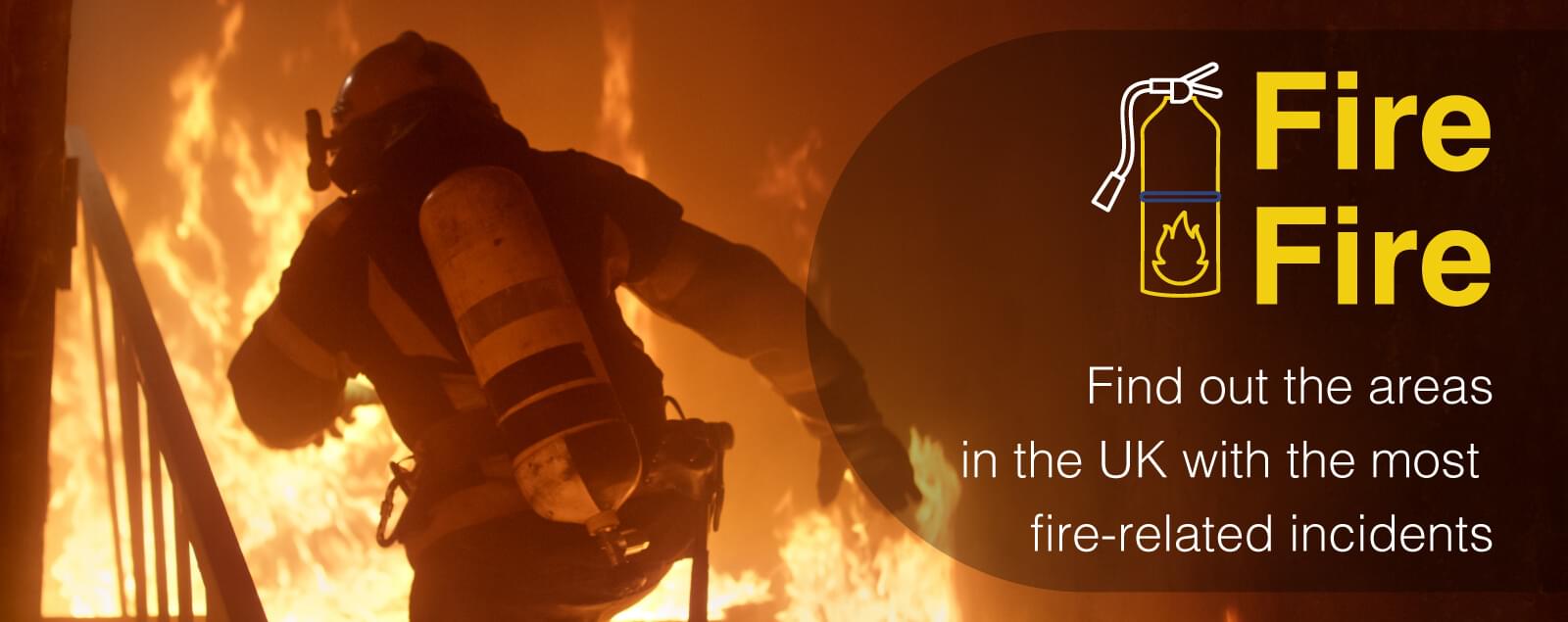
When it comes to your home, it should be a safe haven, a place that is fully protected and secure. That’s why it’s important to ensure that you have a smoke detector/alarm fitted, it makes a huge difference to the safety of your home, especially considering that most home fires start accidentally.
According to research, the lack of smoke alarms or well-functioning smoke and heat detectors is one of the leading causes of dwelling fires in the UK. Recent statistics show that so far there have been 33,387 house fires in 2021/22 alone.
This highlights just how significant it is to have a working smoke alarm/detectors to the overall safety of your home. Installing these devices are one of the best ways to protect your home from fire as they provide early fire and smoke warnings meaning quick action can be taken, incidents avoided and ultimately lives saved. What's more monitored smoke detecors offer that extra level of peace of mind with the emergency services being alerted so thye can act fast.
To help prevent the possibility of a house fire, we have researched the trends relating to fire and rescue incidents as well as reviewed the latest official government statistics. We wanted to find out just how many often fire-related occur as a result of the absence of a smoke alarm and analysed the most common causes of these fires and how many of them are accidental and preventable.
Areas with the most fire and rescue incidents per 100,000 people
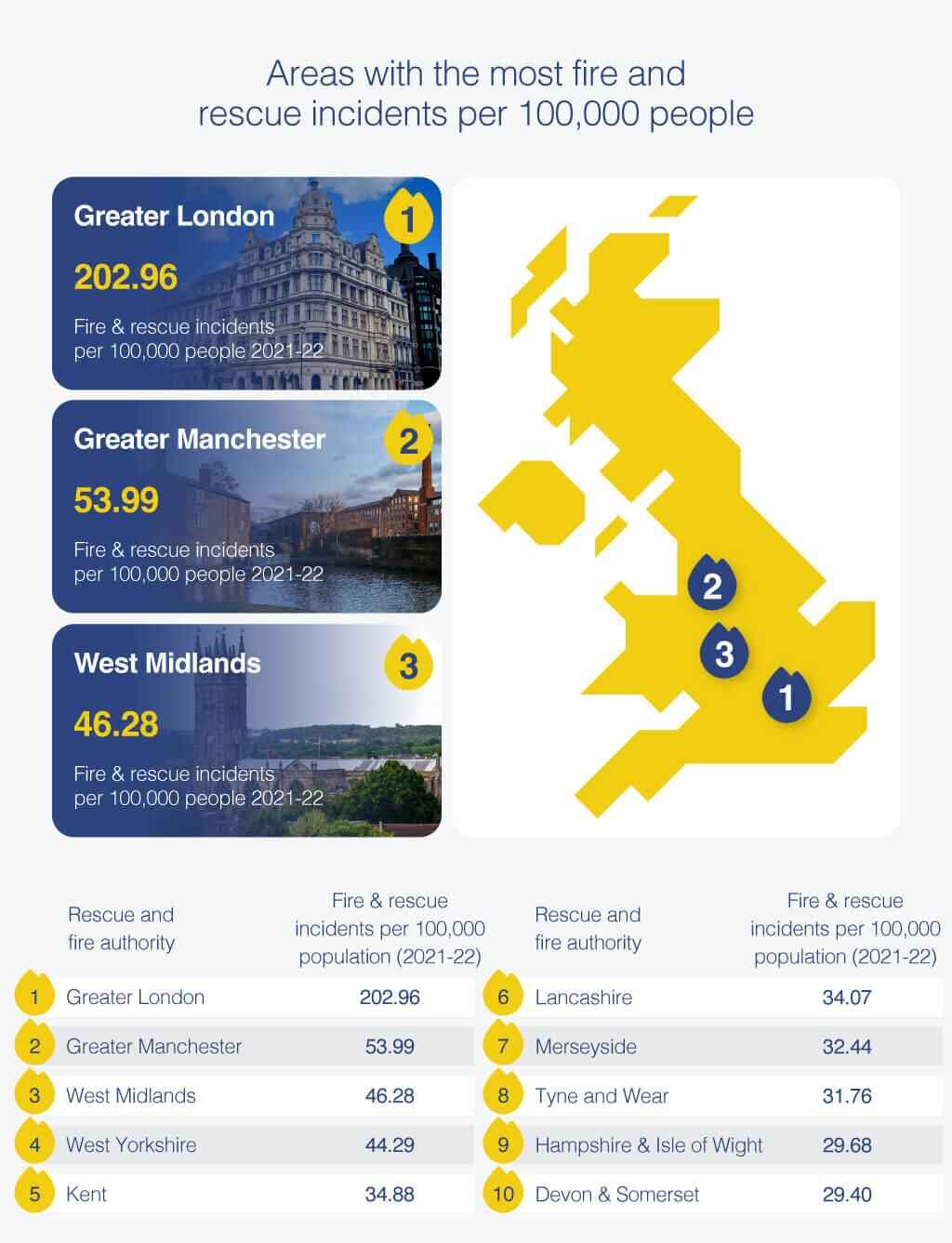
1. Greater London
Fire & rescue incidents per 100,000 people 2021-22: 202.96
Greater London experienced the most fire and rescue incidents by far with a rate of 202.96 per 100,000 people. This rate of fire-related incidents is significantly higher when compared to last year’s figures of 171. Considering the number of fires in the area has also risen by 13.36% and fire and rescue incidents by 18.56%, this perhaps comes as no surprise.
As a response to the rate of fire and rescue incidents per population, the London Fire Brigade introduced a Home Fire Safety Checker. The implementation of this new tool allows residents to carry out a thorough check of their homes and get tailored advice on their smoke alarm systems in just a matter of minutes.
2. Greater Manchester
Fire & rescue incidents per 100,000 population 2021-22: 53.99
Much like the Greater London region, Greater Manchester also experienced a hike in its fire and rescue incidents per 100,000 people. The Metropolitan county experienced a growth of 34.84% in the number of fires in 2021-22. This reflects a rate of 53.99 per population, up from 49.16 last year.
To help tackle the rising rate of fire and rescue incidents, the Greater Manchester Fire and Rescue service resolved to not only offer advice on fire safety but to also help fit a smoke detector in the homes of residents. They also provide occupants with fire-related information and escape plans.
3. West Midlands
Fire & rescue incidents per 100,000 population 2021-22: 46.28
When it comes to fire and rescue incidents per 100,000 people, the West Midlands sits in third place with a rate of 46.28. This rate of incidents shows a slight increase from the previous year which was 44.70.
Interestingly, the percentage of fires in the West Midlands has jumped by 33.85% compared to 2020-21. This continual increase implies the region will need to take more preemptive measures to slow down the rate of incidents per year.
This is particularly highlighted by the fact that fires where a smoke alarm was not present accounted for 24% of all dwelling fires by the end of March 2022.
Areas with the most accidental fires
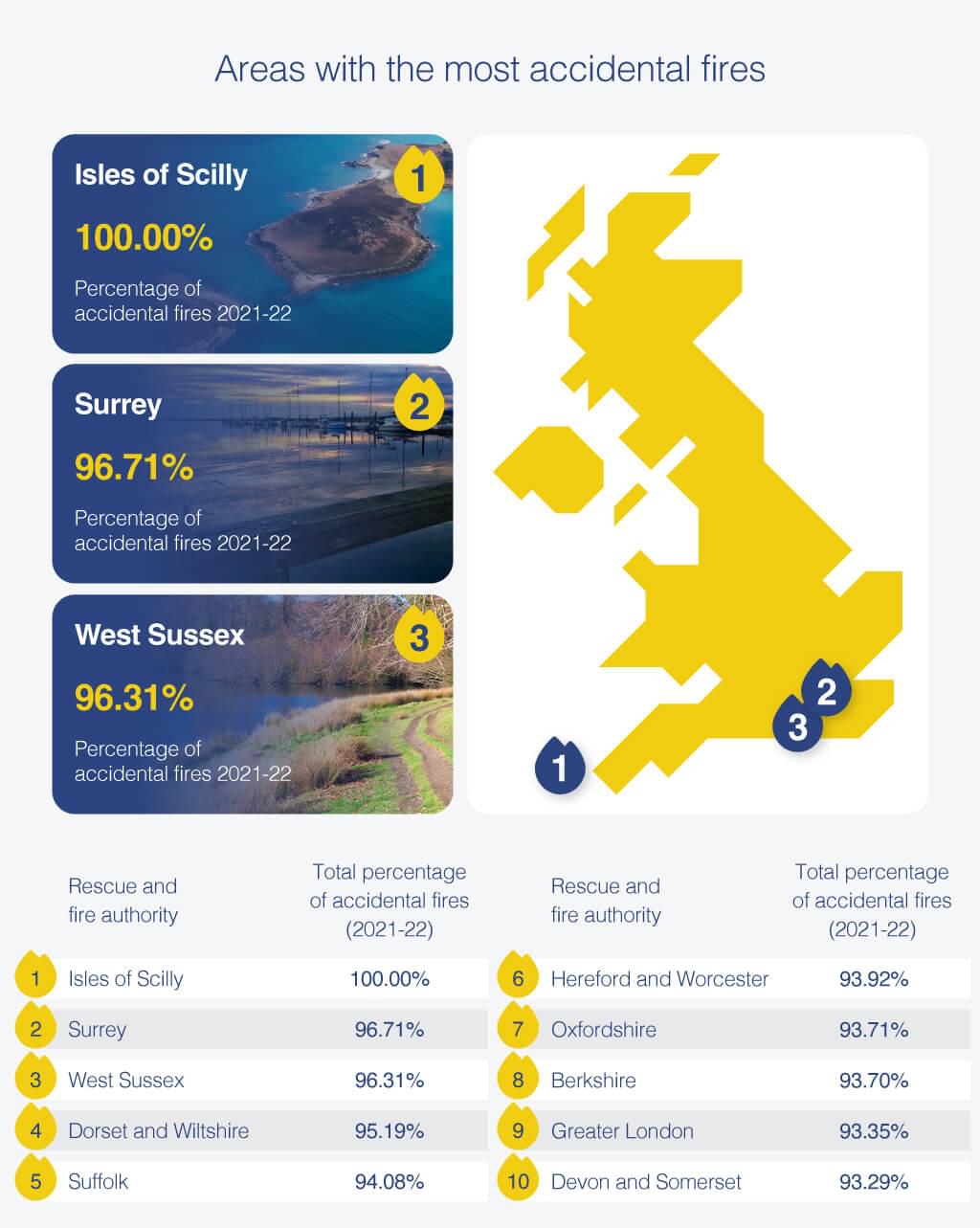
1. Isles of Scilly
Percentage of accidental fires 2021-22: 100%
Located off the Cornish coast, in South West England, the Isles of Scilly experienced the least amount of fires compared to any other area in Great Britain. In fact, due to its population size of just over 2,000 people, the archipelago only had a total of just one fire-related incident which was an accidental fire. Therefore, the Isles of Scilly comes in first place with 100% accidental fires.
2. Surrey
Percentage of accidental fires 2021-22: 96.71%
Surrey grabs the second spot with a total percentage of 96.71% accidental fires. In 2021-22 the non-metropolitan county witnessed a year-on-year difference of 5.88% for its total amount of dwelling fires. It also saw a 6.09% rise in the number of accidental fires.
To combat the rising figures of accidental fires, the Surrey Fire and Rescue Service implemented a prevention service where they visit residents at their homes to provide personalised advice on fire safety. This free service not only runs 24/7 but also helps occupants fit in free smoke alarms.
3. West Sussex
Percentage of accidental fires 2021-22: 96.31%
In 2021-22, West Sussex had one of the lowest amounts of fire-related incidents with 379 and house fires (176) accounting for the bulk of these. The majority of these fires were also classed as accidental with 96.31%.
Although West Sussex experienced a high number of accidental fires it is the only region on the top three list to see a decrease overall. Not only did the region achieve a -5.68% decrease in accidental fires since last year but it also had an even more impressive year-on-year change of -7.33% for all dwelling fires that occurred this year.
Major sources of ignition for accidental fires
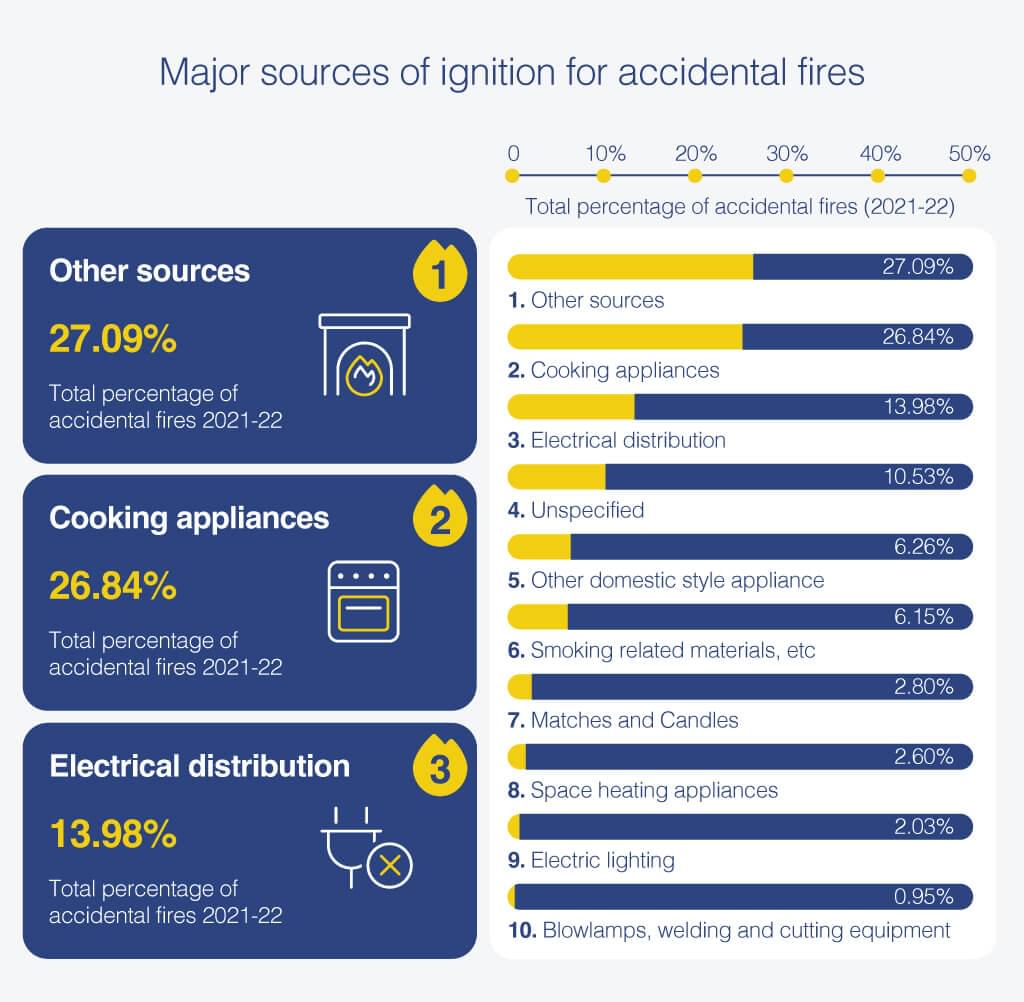
1. Other sources
Total percentage of accidental fires 2021/22: 27.09%
Included in the category 'other' was electrical sparks, naked flames and hot surfaces, this category also shows a steady increase of 3.29% increase in comparison to last year. In 2021-2022 it was the largest category for accidental dwelling fires, accounting for 27.09% of all accidental fires.
Due to the recent increase in accidental fires, England recently updated its smoke alarm regulations. As of July 2022, the revised regulations state that a smoke detector must be installed on every storey of a house, especially if there is a room used for living accommodation.
2. Cooking appliances
Total percentage of accidental fires 2021/22: 26.84%
Although cooking appliances were the largest source of accidental dwelling fires in 2020-21 it still remains in the top three as the second major source of ignition. With a total percentage of 26.84%, it was reported that the misuse of equipment or appliances played a major role as out of the 12,779 that occurred in 2021-22, 7,471 alone were due to mishandling.
3. Electrical distribution
Total percentage of accidental fires 2021/22: 13.98%
The third main ignition source was electrical distribution with 13.98%. This was largely due to faulty fuel supplies, the highest contributing factor overall.
This category also had one of the highest year-on-year increases. Research shows that accidental dwelling fires caused by electrical distribution have risen by 6.50% since last year.
Most common causes of fire - YoY % Change
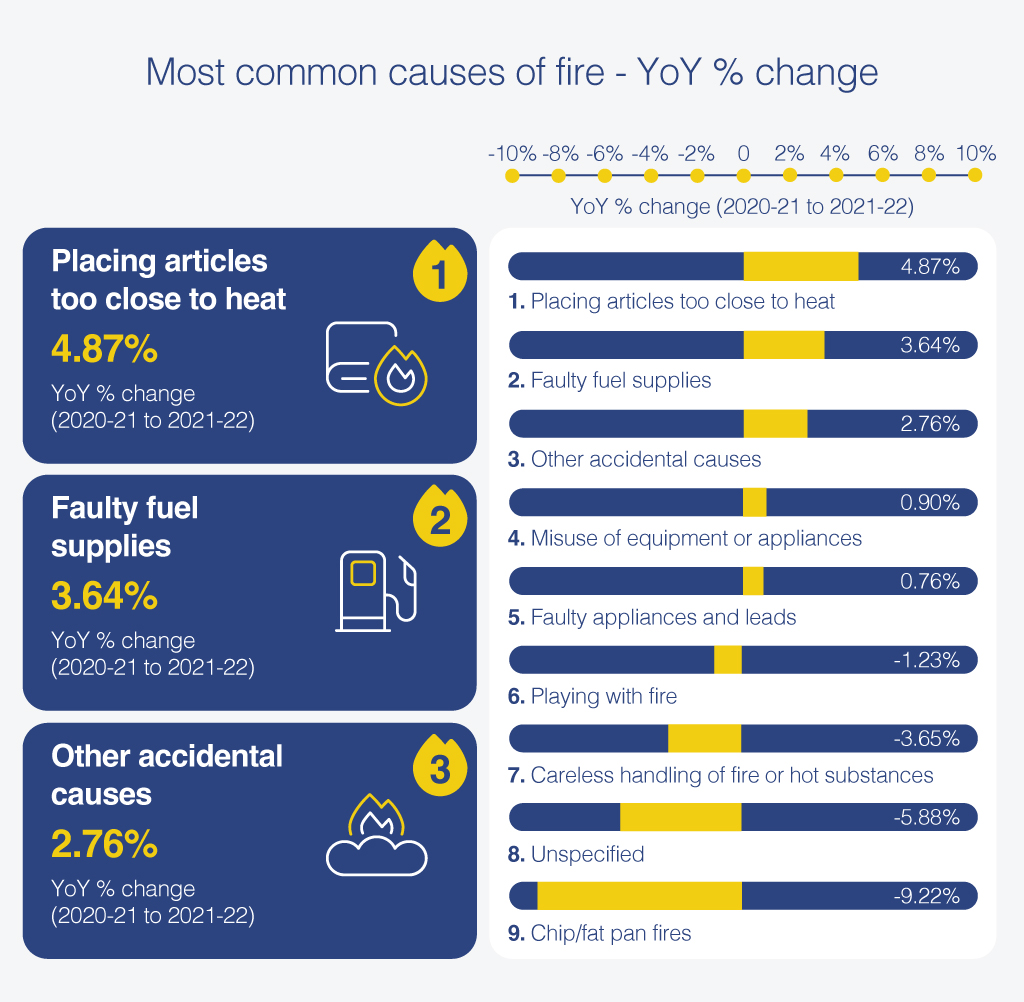
1. Placing articles too close to heat
YoY percentage change 2020-21 to 2021-22: 4.87%
Although the misuse of equipment and appliances has the highest total for the most common cause of fire in England, placing articles too close to heat has the highest year-on-year percentage change. With a steady increase of 4.87%, dwelling fires caused by this category rose from 3,327 in 2020/21 to 3,489 this year.
2. Faulty fuel supplies
YoY percentage change 2020-21 to 2021-22: 3.64%
Faulty fuel supplies follow behind as the second most common cause of dwelling fires in England. Increasing from 2,278 to 2,361, England witnessed a rise of 3.64% in fires caused by this category.
3. Other accidental causes
YoY percentage change 2020-21 to 2021-22: 2.76%
Other accidental causes come in third place. Including things such as flammable liquids and lithium-ion batteries, this category is especially a more prevalent cause of fire in urban areas such as Greater London (172) and Greater Manchester (152). Both these regions witnessed over 100 cases of accidental dwelling fires as a result of other accidental causes, showing a YoY percentage change of 4.87%.
Average response time
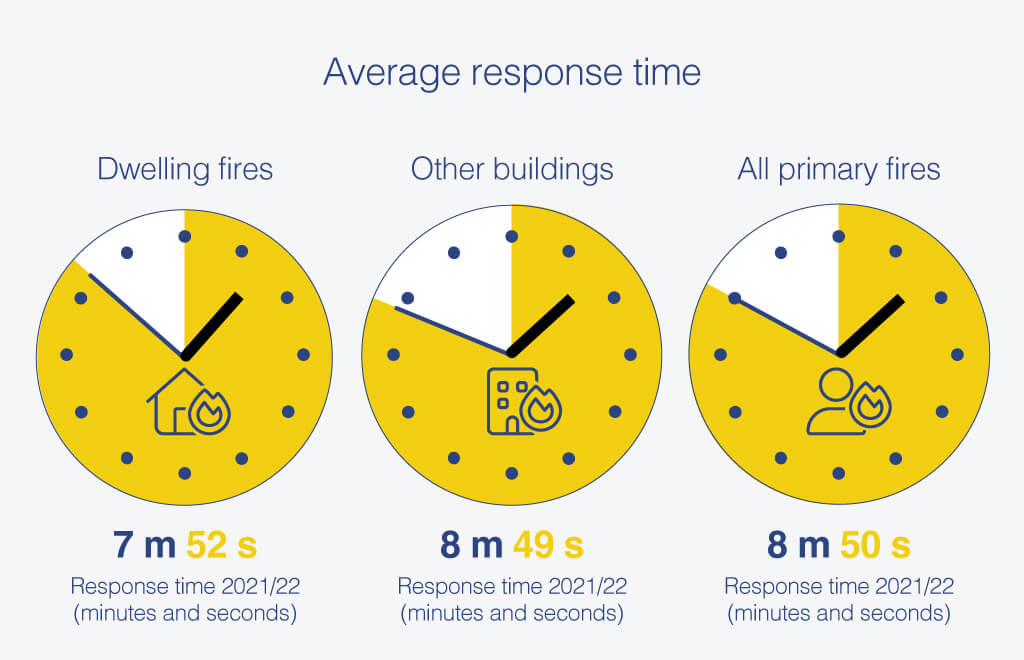
1. Dwelling fires
Response time 2021/22: 7m 52s
When it comes to England’s fire and rescue response times, on average dwelling fires receive the fastest reaction with a response time of 7 minutes and 52 seconds. Interestingly, this shows a slight decline from 2020-21 (7 minutes 36 seconds) which highlights a difference of 16 seconds.
This may largely be because this category is also one of the most common types of fires that occur majorly in housing developments.
2. Other Buildings
Response time 2021/22: 8m 49s
Consisting of unoccupied and derelict buildings, on average, fire-related incidents in other buildings took around 8 minutes and 49 seconds response time as of 2021-22. This is relatively higher than the response time for dwelling fires. What’s more, the response rate was also quicker in the previous year, with a response time of 8 minutes and 36 seconds
3. All Primary fires
Response time 2021/22: 8m 50s
Overall, across the whole of England, all primary fires received the worst response rate with an average of 8 minutes and 50 seconds. However, this takes into account a total of 58,349 incidents which is relatively higher than the year before (56,986) which could be a possible explanation for the slower response rate.
Most common accidental dwelling fires
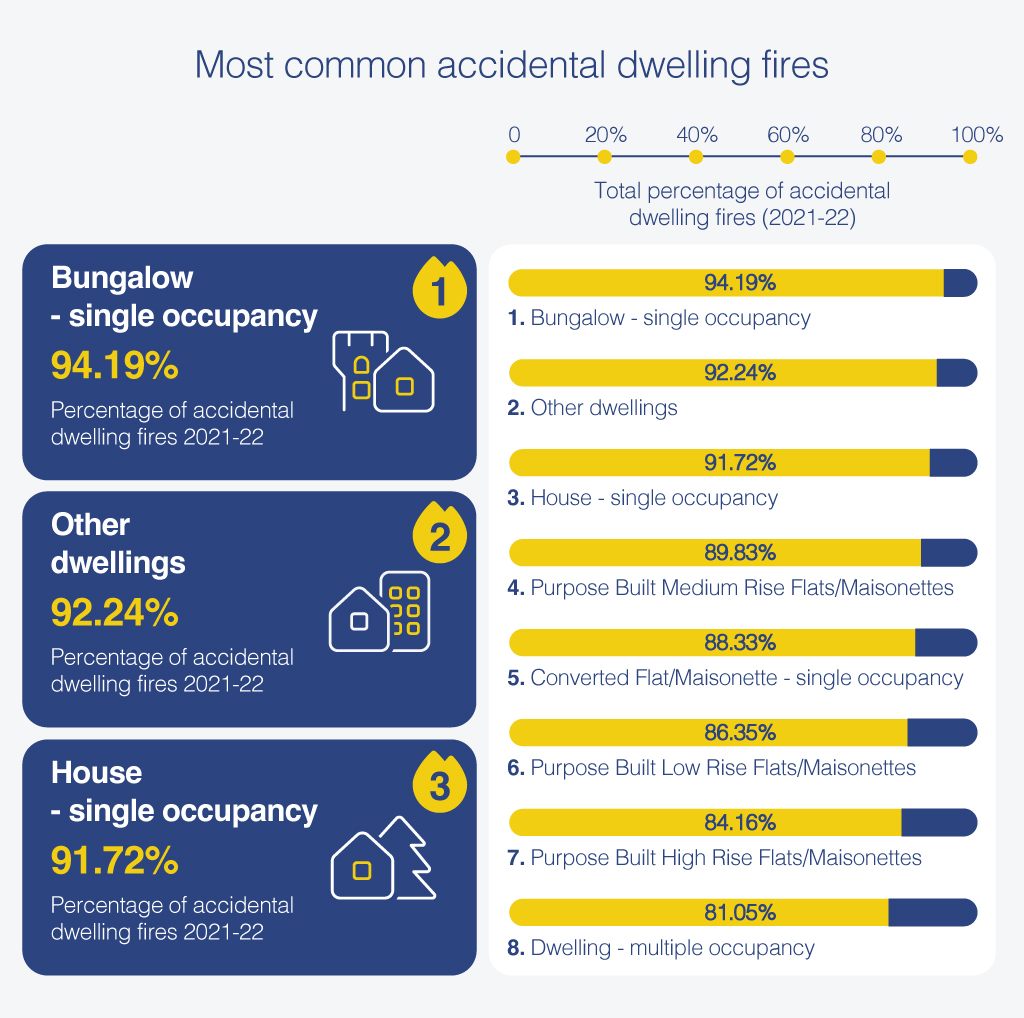
1. Bungalow - single occupancy
Percentage of accidental dwelling fires 2021-22: 94.19%
According to research, bungalows (single occupancy) are the type of buildings that experience the most common accidental dwelling fires. Taking the top position with 94.19% change YoY, this highlights how susceptible bungalows are to fire-related incidents. Also due to there only being one floor, house fires can have a more devastating impact.
2. Other dwellings
Percentage of accidental dwelling fires 2021-22: 92.24%
In second place is other dwellings with accidental fires reaching as high as 92.24%. Taking into account structures such as mobile homes and self-contained sheltered housing, other dwellings witnessed a year-on-year decrease for both its total dwelling fires (-5.07%) as well as accidental dwelling fires (-6.37%) which is an impressive achievement when compared to other buildings.
3. House - single occupancy
Percentage of accidental dwelling fires 2021-22: 91.72%
Following closely behind is single-occupancy housing. With a total percentage of 91.72% accidental dwelling fires in 2021-22, these housing establishments also saw a decrease in the year-on-year percentage change in fire-related incidents.
Though a slight fall in house fires, single occupancy housing experienced a decline in both figures for total dwelling fires (-0.50%) as well as accidental dwelling fires (-0.13%).
Fire and rescue incidents per population
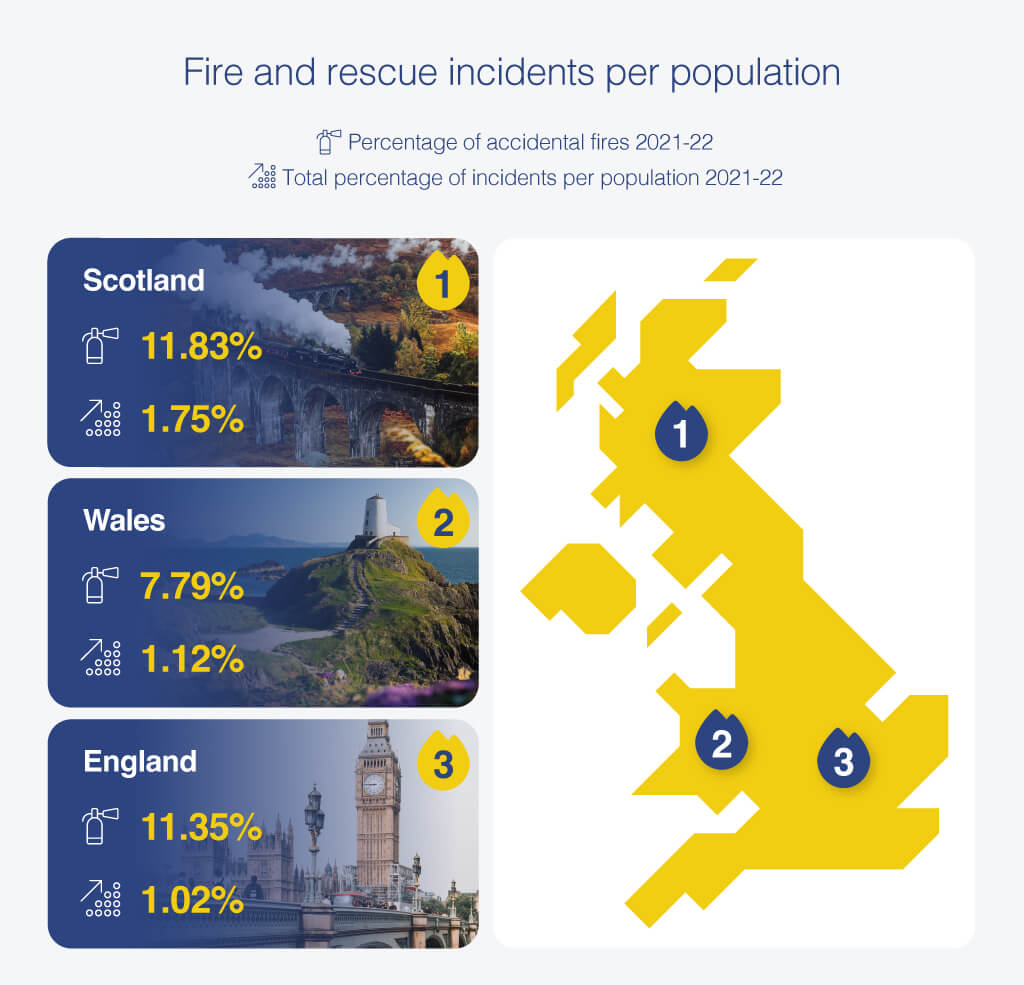
1. Scotland
Total incidents YoY percentage change 2021-22: 11.83%
Total percentage of incidents per population 2021-22: 1.75%
Scotland takes the top spot for the country, not only with the highest year-on-year percentage change, with fire-related incidents rising by 11.83%, but also the highest total of incidents per population with 1.75%.
As a result of having the most house fires per capita when compared to England and Wales, the Scottish government introduced new standards for heat and smoke alarms. Back in February, it was announced that every home must have a smoke alarm in the living room and in other circulation spaces such as landings and hallways.
2. Wales
Total incidents YoY percentage change 2021-22: 7.79%
Total percentage of incidents per population 2021-22: 1.12%
Wales comes in second place with a total of 1.12% per population. This year alone, there were 34,736 incidents in Wales, this equates to around 11,178 incidents per one million people.
Interestingly, the Welsh-speaking country still managed to receive the lowest year-on-year percentage change with an increase of 7.79% in its total incidents. This may be due to the fact that the country places a high focus on fire prevention laws. In July of this year, Wales brought out new smoke alarm regulations for rented homes.
Landlords must comply by ensuring all resented properties have at least one hard-wired smoke alarm on each level of the home, all alarms must also be connected through an interlinking system
3. England
Total incidents YoY percentage change 2021-22: 11.35%
Total percentage of incidents per population 2021-22: 1.02%
Having the largest population by far in the UK, by default England also experienced the most house fires in total with 577,104 incidents attended by the fire and rescue services. This, therefore, saw an increase of 11.35% compared to the previous year.
Of all incidents attended by the fire and rescue services, fires accounted for 26% making it one of the main driving factors in the overall increase of incidents attended this year. However, despite having a huge population of over 56 million people, England still had the least percentage of incidents per population with 1.02%.
Most accidental fires
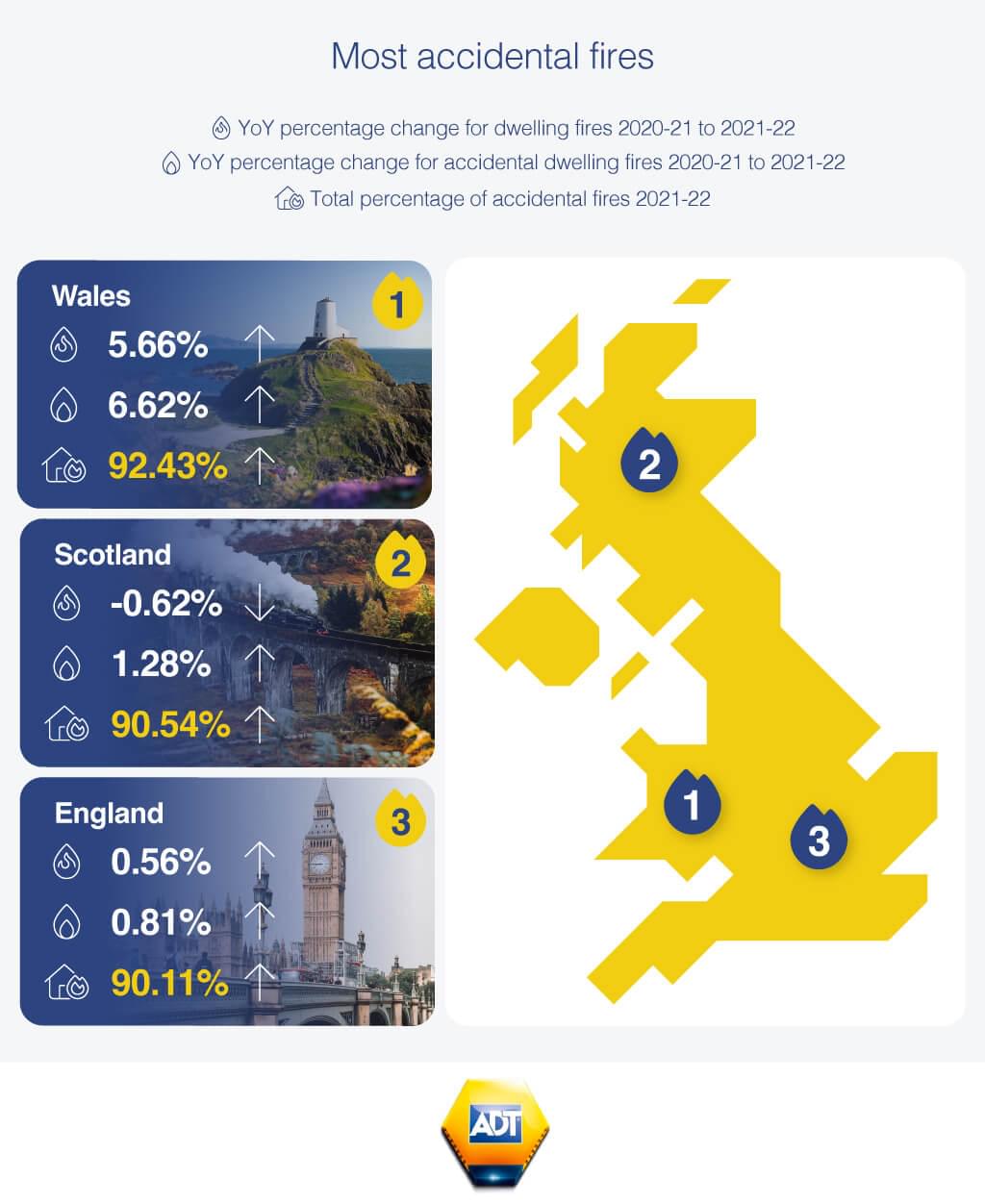
1. Wales
YoY percentage change for dwelling fires 2020-21 to 2021-22: 5.66%
YoY percentage change for accidental dwelling fires 2020-21 to 2021-22: 6.62%
Total percentage of accidental fires 2021-22: 92.43%
Wales witnessed the highest increase in the total percentage of accidental fires with 92.43% of fires being an accident.
When compared to England and Scotland, Wales also saw the highest increase in its year-on-year percentage change for total dwelling fires this year, with a growth of 5.66%. This steady rise can also be seen in the number of accidental fires which shows a difference of 6.62% compared to last year’s figures.
2. Scotland
YoY percentage change for dwelling fires 2020-21 to 2021-22: -0.62%
YoY percentage change for accidental dwelling fires 2020-21 to 2021-22: 1.28%
Total percentage of accidental fires 2021-22: 90.54%
Scotland is the only country in Great Britain to have experienced a decline in its year-on-year percentage change with a -0.62% difference for dwelling fires in comparison to this year.
However, although the country had a slight decrease in its figures for dwelling fires when it comes to accidental fires, this went up by 1.28%. Though not as high as Wales, Scotland’s accidental dwelling fires rose from 4,141 to 4,194 by 2021-22. Overall, with a total percentage of 90.54% for accidental fires, Scotland takes second place.
3. England
YoY percentage change for dwelling fires 2020-21 to 2021-22: 0.56%
YoY percentage change for accidental dwelling fires 2020-21 to 2021-22: 0.81%
Total percentage of accidental fires 2021-22: 90.11%
England saw a slight increase in both its year-on-year percentage change for dwelling fires (0.56%) as well as its accidental fires (0.81%).
On the whole, the country contributed the highest number of dwelling fires in all of Great Britain with 27,169 out of a total of 33,387 fires coming from England alone. However, despite this, it still managed to have the lowest percentage of accidental fires with 90.11%.
Do you want unparalleled protection for your home and family? Click here to find out more about our 24/7/365 monitored smoke and heat detectors today, in the event of a activation rest assured, while you get your family to safety, we’ll contact the emergency services saving valuable time!
Methodology
All information on the UK’s fire and rescue services, as well as causes of fire and response rates, can be found on the Gov.UK. The fire statistics and datasets are from the most recent government figures. This data was collected and then ranked to determine the areas with the highest fire-related incidents.
Other data sources used can also be found here:
UK House Fire Statistics
Fires attended by fire and rescue services



